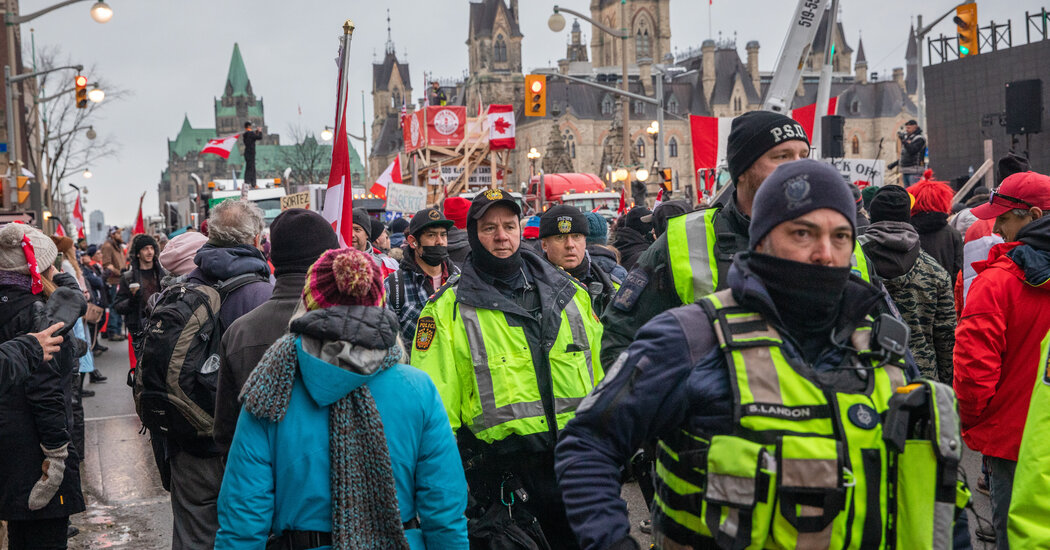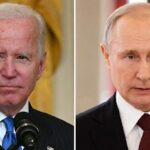
OTTAWA — A two-minute walk from Canada’s Parliament buildings, hundreds of people danced in an intersection that has been barricaded on all four corners by the metal snouts of tractor-trailers. A D.J. worked under a tent, surrounded by giant speakers buzzing with reverb. When a small group of police officers decked in masks and protective headphones made their way across the makeshift dance floor, cheers echoed through the crowd.
Only a few hours earlier on Friday, the premier of Ontario, home to Canada’s capital, Ottawa, declared a state of emergency across the province and said that anyone involved in the protest would face “severe” consequences, including nearly $100,000 fines or even jail time.
On Saturday the Canadian police cleared many trucks from the Ambassador Bridge, a vital crossing in Windsor, Ontario connecting the United States and Canada, and the protesters seemed to be complying.
The bridge blockage had left carmakers short of critical parts, forcing some to shutter some plants in both countries on Friday, and inspired a copycat protest in France.
But the Ottawa police still were not issuing tickets or making arrests.
“They’ve taken an oath to protect our country,” said Terry Grein, a protester in the crowd, after bumping fists with one of the officers. “A civil servant will not go against watching people being unified.”
Two weeks after Ottawa’s downtown was transformed into a raging tailgate party, many in Canada wonder how this happened — why the police seemingly abandoned the country’s seat of power, with no perceivable backup, and how a motley group of truckers, anti-government activists, anti-vaccine agitators and people just fed up after two years of stringent public health restrictions have managed not only to outfox them, but to become increasingly entrenched and to spread elsewhere.
“This is Jan. 6 in slow motion,” said Catherine McKenney, an Ottawa city councilor, who uses the pronouns they/them, referring to the Jan. 6, 2021, mob assault on the United States Capitol. Mx. McKenney has been bellowing for more police protection for the city’s residents downtown, who feel terrorized by pickup trucks that circle through, delivering supplies to the parked trucks. “But on Jan. 7, 2021, Washington emptied out,” the councilor said. “Here, they stayed.”
The answers will surface in a post-mortem, but initially, analysts link the police officers’ hands-off approach to two opposing factors: the weaknesses of the local police force in size and preparation, and the relative strength of the occupiers — in numbers, but also in tactics, discipline, fund-raising ability and logistics.
While the trucks themselves are the purported cause, symbol and tool of the protest, only a few of the self-proclaimed leaders are actually truckers. Some are, in fact, former police officers and army veterans who many believe have used their expertise to help organize the occupation.
“This is an entirely sophisticated level of demonstrators,” Ottawa’s police chief, Peter Sloly, said in a news conference on Thursday. “They have the capability to run a strong organization here, provincially and nationally, and we’re seeing that play out in real time.”
The trucks began roaring into the city on Jan. 28, spurred by new federal regulations requiring truckers crossing into Canada from the United States to be vaccinated against the coronavirus. But the scope of their demands was more expansive, calling for removing all pandemic restrictions in Canada, and they called on Parliament to be dissolved and Prime Minister Justin Trudeau to be removed from office.
City councilors briefed by the police were told to expect an exceptionally large convoy that would be disruptive — and loud — but most likely temporary.
“The overall sentiment at the point: By late Sunday or Monday, it would move on,” Mx. McKenney said.
Instead, the trucks parked in tight groups along many streets downtown, including on the graceful boulevard that passes before the country’s august Parliament buildings, Supreme Court and political offices, including the prime minister’s. And they never left.
The police did not put down concrete barriers to keep the trucks a safe distance from the legislature, nor did they ensure that the downtown core would not be converted into a parking lot — until days later, and then only to stop further expansion.
It was only at that point that everyone understood how a 30,000-pound tractor-trailer that a trucker may live in for days at a time while on the job could be converted into a strategic tool of protest — huge and immovable, equipped with a heater and a bed, and with a built-in, ear-shattering noise maker.
In some cases, the truckers removed their tires and bled their brake lines to make their trucks immovable, the police said. And some heavy duty towing companies have refused to work with the police to remove the trucks, Mr. Sloly said, as some have been threatened and others are sympathetic to the truckers, who are their major clients.
It was not just that the trucks were immovable. The police were also greatly outnumbered and outflanked.
“It had to do with a failure of imagination,” said Michael Kempa, an associate professor of criminology at the University of Ottawa who studies policing across Canada. “It was outside our frame of experience because of that failure.”
Ottawa is a small city, with about one million residents, and has a police force to match, with fewer than 1,500 officers. That comes to one officer for every 667 residents, a far cry from New York City, with one officer for every 233 people.
A week into the occupation the police reported that they had moved their shifts around, managing to put 150 officers on the streets in three of the most affected neighborhoods over the course of a day, and swearing in new federal officers sent to help.
At that time, Chief Sloly said, there were about 5,000 protesters settled into the city’s core.
The mayor declared an emergency and Chief Sloly requested an additional 1,800 police officers. But still, there were too few officers to handle the crowds. While trying to make an arrest, some of his officers were swarmed.
On Friday, Mr. Trudeau — whose name linked to a popular epithet has become the unofficial slogan of the occupation, written on knit caps, hats, flags, handwritten signs and the side of a giant truck stationed squarely in front of the gates to Parliament — rejected calls to order the military to clear the city’s streets or some of the border crossings into the United States that had been blocked by similar convoys.
Over that time, money to support the convoy in Ottawa — much of it from the United States — has poured in. The organizers have held regular news conferences in hotel rooms, for the media outlets they deem trustworthy. They sent a lawyer to court to represent them in a nascent class action suit.
And they got organized, setting up street captains who reported to block captains. Together, they distribute food and supplies to sustain the protesters and, most important, deliver diesel to the trucks in jerrycans. As of last weekend that was deemed a crime, but it continues unabated.
On Monday, when a local court imposed a 10-day prohibition on honking, the more than 400 trucks barricading dozens of blocks suddenly went silent — revealing both an adept communications network and notable discipline, said Regina Bateson, an assistant professor of public and international affairs at the University of Ottawa.
“They’ve been given this amazing gift of time by the authorities here,” said Ms. Bateson, who studies political violence, collective activism and populism. “With that time, they have formed relationships, they’ve gone out and partied together. It’s actually important — that’s how groups form cohesion.”
She added, “That gives them the trust and confidence to go into combat together.”
A 15-minute drive from downtown, one of the occupation’s command centers has been set up in the stadium parking lot of the Ottawa Titans, a minor-league baseball club.
A half-dozen large white tents have been built, with electricity and heat pumping into them. Inside one, cooks offer hot dogs and soup to dozens of people sitting at tables, surrounded by donations of toothpaste, toilet paper and juice. In another, deemed the office, volunteers check in to pick up money or get their marching orders. A couple of white boards offer services not normally associated with protests — the numbers for a mechanic, an electrician and a person with keys to a cage of propane tanks out back near piles of wood. Portable toilets and two saunas — their chimneys leaking smoke — sit near by.
“This looks like more than just some friends of truckers who showed up in Ottawa,” said Christian Leuprecht, a professor of political science at both the Royal Military College of Canada and Queen’s University in Kingston. “These are people who were very determined, very organized, very well resourced and very well led.”
Some of the convoy’s leaders have military or policing backgrounds that many analysts say have helped shape their strategy and planning. The group’s proclaimed head of protective intelligence, Tom Quiggin, was an intelligence officer for the Canadian military, cabinet office and federal police. Another was a former police officer in Ottawa with the federal Emergency Response Team.
“They know exactly what the tactics are that police are going to use,” said Mr. Leuprecht, who studies national security, terrorism and international crime.
Two weeks after the first trucks arrived, some of the extra forces that Chief Sloly had been begging for, drawn from around Ontario, have appeared on the streets, sometimes in large groups. But still, they remain greatly outnumbered and inactive. Groups of protesters wheel jerrycans in wagons past them, honk their truck horns in time with the music as people dance and remain squarely parked on the street.
Former military and police officers have also made public pleas for recruitment this week — for the convoy.
Sarah Maslin Nir contributed reporting from Ottawa.




